
Phoenix is the capital and most populous city of the U.S. state of Arizona, with 1,608,139 residents as of 2020. It is the fifth-most populous city in the United States and the most populous state capital in the country.
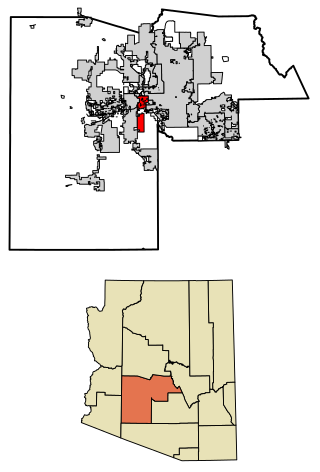
Avondale is a city in Maricopa County, Arizona, United States, adjacent to Phoenix. As of the 2020 census, the population of the city was 89,334, up from 76,238 in 2010 and 35,883 in 2000.

Scottsdale is a city in the eastern part of Maricopa County, Arizona, United States, and is part of the Phoenix metropolitan area. Named Scottsdale in 1894 after its founder Winfield Scott, a retired U.S. Army chaplain, the city was incorporated in 1951 with a population of 2,000. At the 2020 census, the population was 241,361, which had grown from 217,385 in 2010. Its slogan is "The West's Most Western Town". Over the past two decades, it has been one of the fastest growing cities and housing marketings in the United States.

Sun City is an unincorporated community and census-designated place in Maricopa County, Arizona, United States, that is located within the Phoenix metropolitan area.

Camp Verde is a town in Yavapai County, Arizona, United States. As of the 2010 census, the population of the town is 10,873.

Downtown is the oldest district in Salt Lake City, Utah, United States. The grid from which the entire city is laid out originates at Temple Square, the location of the Salt Lake Temple.

Downtown Phoenix is the central business district (CBD) of the City of Phoenix, Arizona, United States. It is in the heart of the Phoenix metropolitan area or Valley of the Sun. Phoenix, being the county seat of Maricopa County and the capital of Arizona, serves as the center of politics, justice and government on the local, state and federal levels. The area is a major center of employment for the region, with many financial, legal, and other national and international corporations housed in a variety of skyscrapers. Major arts and cultural institutions also call the area home. Downtown Phoenix is a center of major league sports activities, live concert events, and is an equally prominent center of banking and finance in Arizona. Regional headquarters for several major banks, including JP Morgan Chase, Wells Fargo, US Bank, Bank of America, Compass Bank and Midfirst Bank are all located within or close proximity to the area.

Phoenix Municipal Stadium is a baseball stadium, located in Phoenix, Arizona. It is often referred in short as Phoenix Muni. The stadium was built in 1964 and holds 8,775 people. It is currently the home to the Arizona State Sun Devils baseball program, having relocated to Phoenix Municipal Stadium at the start of their 2015 season. It is the former spring training home to the Oakland A's, having played their home games from 1982 to 2014. The San Francisco Giants held spring training at the ballpark from 1964 to 1981, when they moved to Scottsdale Stadium.

The Dean Lindsey Memorial Tunnel, better known to Phoenix residents as the Deck Park Tunnel, is a vehicular underpass built underneath Downtown Phoenix. It was built as part of Interstate 10 in Phoenix, Arizona.
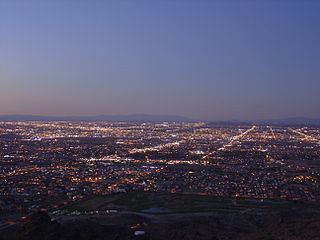
South Phoenix is a region of Phoenix, Arizona. By one definition it encompasses an area south of the Salt River, north of Roeser Road, east of 24th Street, and west of 32nd Street.

The Phoenix Street Railway provided streetcar service in Phoenix, Arizona, United States, from 1888 to 1948. The motto was "Ride a Mile and Smile the While."
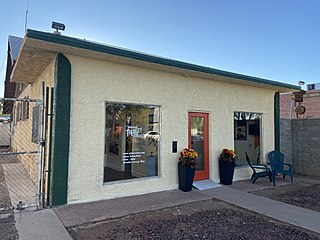
The Phoenix Trolley Museum, incorporated as the Arizona Street Railway Museum, is a railway museum established in 1975, with an emphasis on preserving historical street cars in Phoenix, Arizona, USA. The museum is "dedicated to the preservation of original Phoenix trolley cars and memorabilia, and to showing their place in the history of America's fifth largest city."
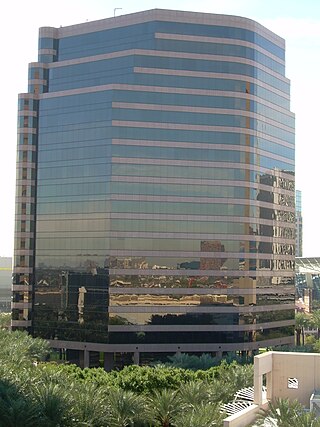
Arizona Center is a shopping center and office complex located in downtown Phoenix, Arizona.
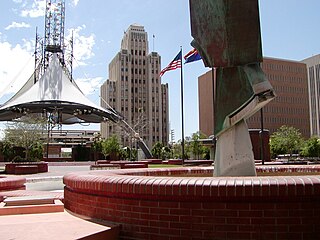
Patriots Square Park was an urban park located in downtown Phoenix, Arizona. The space has been redeveloped as part of the larger CityScape office and retail project; large portions of the park were demolished as of the spring of 2009. Before the CityScape project broke ground in the fall of 2007, Patriots Square Park was a 2.5 acre mixed-use park containing open space, an outdoor performing arts stage, and food concessions. The park also served as a decorative cover for a public parking structure located underground which still remains and is in use.

The Arizona Science Center, at 600 Washington St in Downtown Phoenix, Arizona, is a science museum located in Heritage and Science Park. It was founded in 1984 as the Arizona Museum of Science & Technology in a downtown storefront. Its current building, designed by Antoine Predock, was completed in 1997. Along with daily demonstrations throughout the Center, the Center provides shows in the Dorrance Planetarium and in a five-story, giant screen IMAX Theater.
The transportation system of Arizona comprises car, rail, air, bus, and bicycle transport.
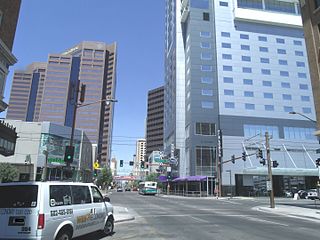
The Central Avenue Corridor is a significant stretch of north–south Central Avenue in Phoenix, Arizona. Roughly bounded by Camelback Road to its north, and McDowell Road to its south, this is one of Phoenix's most vital and heavily trafficked stretches of roads. It is also one of the region's largest centers of employment, with nearly 60,000 people being employed within a three-mile (5 km) radius of this swath of Central Avenue. Major employers here include major banks and financial institutions, hi-tech companies, and several significant law firms and government agencies.

The Chinese Cultural Center, now the Outlier Center, was a Chinese-themed retail complex in Phoenix, Arizona. It was developed in 1997 by BNU Corporation, a subsidiary of COFCO, a Chinese state-run enterprise and the country's largest food processor, manufacturer and trader. Although the center was developed as a for-profit investment by its owners, it was portrayed as a "cultural center" for the Chinese community in the greater Phoenix area. The developers thought the traditional Chinese architecture and landscaping, its concentration of Chinese-related businesses, and its use as a venue for celebrating Chinese holidays would attract both tourists and local Asian-Americans, and make Chinese business people feel more at home and welcome in Phoenix, thus helping Phoenix attract more foreign investment. The center opened in 1998 with visual elements imported from China and installed by Chinese craftsmen. It struggled with low occupancy, suffered further during the recession of the mid-2000s, and never recovered. In 2017, a new owner announced the property would be repurposed as a modern office building and the distinctive Chinese roof would be removed. This led to a sustained multi-year effort by the Chinese-American community to block the redevelopment and preserve the center as it was built. Despite demonstrations, petitions, lobbying, and several lawsuits, the new owner ultimately prevailed and all Chinese elements were gone by 2022.
The following is a timeline of the history of the city of Phoenix, Arizona, United States.

Grand Canyon Pioneer Cemetery, also known as Pioneer Cemetery, is a historic cemetery located near the Grand Canyon's South Rim. It is also known as South Rim Cemetery and the American Legion Cemetery due to its association with the veterans' organization.



















